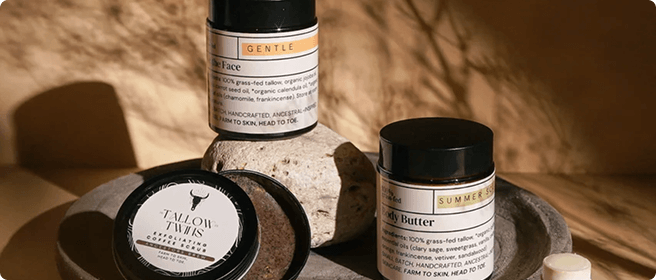Seed oils seem to be under fire lately, causing a lot of controversy about “good” oils and “bad” oils. You’ve probably seen the debate over popping up in conversations with industry professionals, scholarly articles, TikTok videos, and X posts. It seems that everyone has an opinion on seed oils, which is fair enough, considering almost everyone is consuming them. If you cook with common oils, rely on pre-packaged foods, or eat out at most restaurants, chances are you’re ingesting them daily.
What Are Seed Oils?
Seed oils are made by extracting oil from the seeds of plants like soybeans, corn, sunflower, canola, and safflower. These oils became popular in the mid-20th century as they were seen as a cheaper and "healthier" alternative to animal fats - like butter, lard and tallow. But the more we’ve learned about the body and the way it processes these oils, the more we’re realizing that these fats might not be as innocent as they once seemed back in the day.
The Damage
Seed oils are highly processed and loaded with omega-6 fatty acids, which are pro-inflammatory. In small amounts, omega-6s are essential for our bodies to function properly. The problem is, modern diets are majorly overloaded with them, especially when they come from processed foods. This imbalance between omega-6 and omega-3 fatty acids (the anti-inflammatory kind) can contribute to a range of health issues, from heart disease to autoimmune disorders, weight gain. Mental health issues have also been linked to this imbalance - including depression and anxiety (great..).
But that’s not all. Seed oils are often chemically refined at high temperatures, which can create harmful compounds, including trans fats. These trans fats are linked to clogged arteries and increased risk of cardiovascular disease.
Plus, the process of extracting seed oils typically involves a lot of synthetic chemicals. Think about it: You’re eating something that’s gone through multiple rounds of industrial processing, which makes it far from a "natural" option. It's not exactly the "whole food" we’d want to nourish our bodies with.
Why Seed Oils are on Everyone’s Lips
As people become more educated about food, the tide is turning away from processed and refined ingredients. The wellness community is leading the charge, shining a light on the dangers of seed oils, especially with the rise of influencer-driven health trends. More people are realizing that the foods they’ve been eating for decades (often labelled as “heart-healthy”) may actually be causing more harm than good. The debate over seed oils, like canola, soybean, and sunflower oil, has grown beyond health circles to spark broader cultural and even political discussions in 2024.
There's also been an increasing awareness of the connection between diet and inflammation. With the surge in inflammatory-related diseases like autoimmune disorders, gut issues, and chronic fatigue, more and more people are turning to cleaner, whole-food alternatives to restore balance in their diets.
The History of Fats: From Animal Fats to Seed Oils and Back Again
If we look back through history, our ancestors ate mostly animal fats like tallow, lard, and butter because they were nutrient-dense and stable for cooking. These fats have been part of the human diet for centuries, providing vitamins like A, D, E, and K.
In the 20th century, the rise of vegetable oils began to take off. During and after World War II, these oils became more accessible, and their low cost made them the go-to option for cooking. Food companies loved them for their long shelf life and light texture. Over time, the narrative shifted, and seed oils were promoted as a healthier alternative to animal fats, often with misleading claims of heart health.
Fast forward to today, and with all of the research pointing to the downsides of omega-6-heavy oils, we’re slowly seeing a return to traditional fats. Tallow, in particular, is making a comeback as the ultimate cooking fat, due to its stability, high smoke point, and impressive nutrient profile. We can preach the benefits of tallow for your skin all day, but as these discussions have become more prevalent in the wellness community, we decided it was time to do our research on tallow in the kitchen.
Tallow: The New Liquid Gold
So, what makes tallow so great as a cooking oil? Well, for starters, tallow is made from beef fat, specifically the fat from the cow’s belly or other areas with higher fat content. Unlike seed oils, tallow is minimally processed, and it’s packed with healthy saturated fats, which help support hormone health, reduce inflammation, and boost energy.
But the real magic of tallow comes from its nutrient density. Tallow contains fat-soluble vitamins that are essential for immunity, skin health, bone health, and overall wellness. It also boasts conjugated linoleic acid (CLA), a fat known for its anti-inflammatory properties and potential benefits for fat loss. Tallow has a high smoke point of around 400°F (204°C), making it perfect for high-heat cooking methods like frying and searing without the worry of producing toxic compounds. Compare this to seed oils, which start to break down at lower temperatures, releasing harmful free radicals and oxidation products.
The Bottom Line
Seed oils have been marketed as health foods for decades, but the more we learn about nutrition and inflammation, the more we realize they don’t belong in our kitchens. They’re inflammatory, heavily processed, and can contribute to a variety of health problems. As the wellness world has woken up to the harm they cause, more people are rediscovering the health benefits of traditional fats like tallow.
Tallow isn’t just for frying potatoes anymore- it’s the nutrient-packed, stable, and clean alternative to highly processed seed oils. So, if you’re looking to take your health to the next level, it’s time to swap out those seed oils for some liquid gold (AKA tallow, but we will accept butter or ghee) in your kitchen. Your body and your taste buds will thank you.




